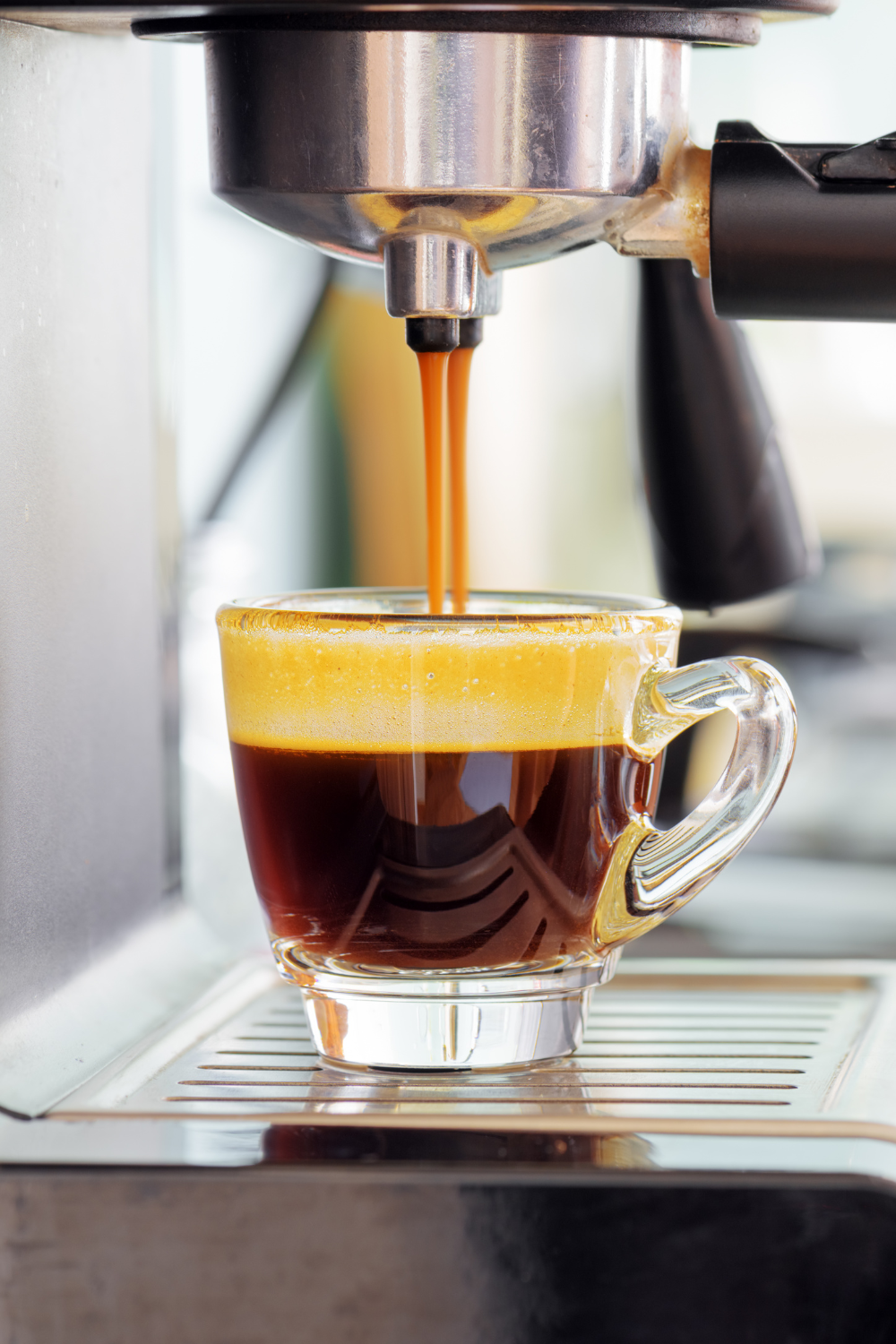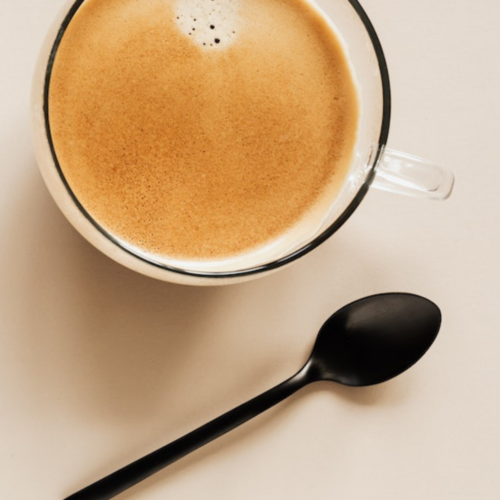There are a thousand ways to make a cup of coffee. Today, I’ve got great news, because we’ll be exploring a delightfully sweet drink called the Spanish Latte!
Spanish Latte isn’t what you might call an “officially recognized” specialty coffee drink. There’s a lot of confusion (and debate) about what actually constitutes this drink.
In this article, we’ll cover the original Spanish Latte – called “Cafe con Leche” – and some popular recipes like the Cuban latte. I’ll explain what makes the drink unique from your standard cafe latte, how it started, where to find it, and how to prepare one of your own at home.

This post includes affiliate links.
Cafe Con Leche
The original Spanish Latte is called cafe con leche, meaning “coffee with milk.”
Cafe con leche combines equal parts of strong coffee and scalded milk, usually with a sweetener.
While this drink is usually prepared using espresso, it’s possible to make it with strong dark-roasted coffee. The most common alternative is a stove top Moka pot.
Most other latte recipes use steamed milk, created with a steam wand appendage of an espresso machine. Cafe con leche uses scalded whole milk instead. This means the milk is brought to a frothy consistency on the stove top at a temperature just below boiling.
A Spanish Latte is uniquely creamy because of the 1:1 ratio of milk and coffee. Milk decreases the bitterness of the espresso. And when it’s scalded, the lactose provides a natural sweetness.
Another unique aspect of this drink is that sweetener is often added to the bottom of the cup, before coffee or milk.
How big is a cafe con leche? It varies widely, but it’s a 6-ounce drink in many cases. That translates to about 225 mg of caffeine. The color presentation is a peachy brown.
Cuban Latte
This little drink is a popular variation on the traditional cafe con leche, using sweetened condensed milk.
It goes by many names, at a coffee shop, you’ll see it most often called Cuban Latte.
This drink was popularized across North America by Cuban communities in Florida, as this is a daily drink amongst this community. You can find it served at walk-up cafe and bakery windows called “ventanitas.”
You may also hear it referred to as Havana Latte, Cafe Cubano, or sometimes Havana Cappuccino.
Unlike your standard cafe con leche, a Cuban latte uses both regular and condensed milk. In place of another sweetener, condensed milk is added to the bottom of the cup. Then espresso. And scalded whole milk to top it.
In most cases, a Cuban latte will be thicker and sweeter than a traditional cafe con leche. And a portion of the espresso-condensed milk mixture will rise to the top of the cup, creating a layer that resembles crema is one of the essentials when it comes to this drink!
Spanish Latte vs. Café Latte
While the names sound alike, there are probably more differences between a Spanish latte and a café latte recipes than there are similarities.
Dose
To start with, the coffee-milk ratio is different.
A Spanish latte is prepared using equal parts milk and coffee. A café latte is traditionally prepared with 3 parts milk for every portion of coffee. In some cases (hello Starbucks!), a latte will be prepared with more than 10 parts milk for every portion of coffee.
In short, a regular latte can get milky. Very milky. And a Spanish latte is always much stronger.
Preparation of Milk
Both drinks are best made with whole milk, which has a rich consistency and is great for latte art. The core difference is in how it is prepared.
With a cafe latte, the milk is steamed using an espresso machine wand. In some cases, the milk is also frothed to add a small amount of foam.
You don’t need a steam wand to prep a Spanish latte. Instead, milk is scalded using the radiant heat of a stovetop. The milk is stirred as it heats until almost boiling.
Espresso
Both drinks are traditionally prepared using espresso.

But, in the case of a Spanish latte, espresso is less of a strict requirement. You can also make the drink using dark-roast coffee in a Moka pot.
Sweetener
A sweetener is the first ingredient added to the cup when preparing a Spanish latte. The most common option is granulated sugar. Use it if you’re preparing a traditional cafe con leche.
Substitute sweetened condensed milk for a Cuban latte.
Many people like adding sweeteners and flavor syrups to their cafe lattes. These inclusions are usually done after coffee and before milk.
Nutrition
Are you counting calories? If so, it’s worth understanding the nutritional difference between a cafe latte and a Spanish latte.
Condensed milk has about 2x the calories of an equivalent portion of whole milk. Therefore a Spanish latte will usually have more calories than an equivalent portion of a cafe latte.
To be fair, this comparison is a bit like apples and oranges. Spanish latte has proportionally more espresso and less milk, by volume than cafe latte. And it’s usually served shorter.
What’s the main takeaway? Condensed milk significantly impacts the drink’s sugar and calorie content.
Where To Get A Spanish Latte
If you’re looking for a traditional Spanish Latte, they’re widely available.
In most third-wave coffee shops, you can look for the name “cafe con leche” or “cafe au lait,” which is the French equivalent.
The Havana version isn’t as mainstream, but most Cuban offer them and some mainstream cafes in larger cities. This drink also tends to go on seasonal rotation at bigger chains (like Peets) and is not difficult to make at home.
How to Make A Spanish Latte
Fortunately for you and me, the Spanish latte isn’t exactly a third-wave coffee order. It’s simple enough for most folks to make at home.
Equipment
Espresso Machine – In order to get the most authentic version of a Spanish latte, this drink should be prepared using espresso. By using a real espresso machine, you’ll get maximum flavor, balance, and intensity from your espresso.
If you’re on the fence about which machine is right for you, check out our favorite espresso machines on the market here!
OR
Moka Pot – The problem with espresso machines is that they’re an expensive piece of coffee gear. If you don’t have one, then a stovetop Moka pot will also create a good result.
Ingredients
Water – Always start with filtered or bottled water, if you can. Coffee is mostly water, so any contaminants or additives in your tap will color the cup. For example, if your city adds chloramine, you’ll taste it in the final drink.
Coffee – Reach for a robust dark-roasted coffee bean, and grind it to a very fine consistency.
Whole Milk – To be fair, you can use any milk for this drink. But the best dairy option is whole milk. It has an awesome texture and is rich enough to dampen the espresso’s bitterness.
Sugar (optional) – Most people like granulated sugar for cafe con leche. I like fine grain unbleached sugar or sugar in the raw. Feel free to substitute with your preferred sweetener.
Condensed milk (for Cuban Latte) – If you’re preparing the Cubano version of this drink, find a can of sweetened condensed milk to use as your sweetener.

Spanish Latte
Equipment
- Espresso Machine
Ingredients
- Water
- Espresso beans
- Whole milk
- 2 tsp Sugar optional
- 3 tbsp Condensed milk for Cuban latte
Instructions
- Pre-Heat The Mug – Pour boiling water into your mug to pre-heat it while your coffee and milk are prepared. Ultimately, this simple step will allow your drink to remain hot for longer.
- Scald The Milk – Heat the whole milk in a small saucepan over medium-low heat until it begins to steam and small foam bubbles form. Do not let it boil. You should stir it periodically with a wooden spoon so that the heat is evenly distributed and a film doesn’t form across the top of the pan. Lower the temperature slightly when the milk is ready to keep it warm while you prepare the espresso.
- Prep The Coffee – Pull 3 ounces of espresso for this drink, or prepare an equivalent volume of coffee using a Moka pot. Always start with filtered water, if you can, and use a very fine ground coffee.
- Assemble The Drink – Pour out any hot water used to preheat the mug. Add your sweetener. I’d recommend 2 tsp of granulated sugar or 3 Tbsp of sweetened condensed milk (for cafe cubano). Next, add the espresso. With a small spoon, stir to combine the espresso and sweetener. Top with 3 ounces of scalded milk.
Notes
Instructions
- Pre-Heat The Mug – Pour boiling water into your mug to pre-heat it while your coffee and milk are prepared. Ultimately, this simple step will allow your drink to remain hot for longer.
- Scald The Milk – Heat the whole milk in a small saucepan over medium-low heat until it begins to steam and small foam bubbles form. Do not let it boil. You should stir it periodically with a wooden spoon so that the heat is evenly distributed and a film doesn’t form across the top of the pan. Lower the temperature slightly when the milk is ready to keep it warm while you prepare the espresso.
- Prep The Coffee – Pull 3 ounces of espresso for this drink, or prepare an equivalent volume of coffee using a Moka pot. Always start with filtered water, if you can, and use a very fine ground coffee.
- Assemble The Drink – Pour out any hot water used to preheat the mug. Add your sweetener. I’d recommend 2 tsp of granulated sugar or 3 Tbsp of sweetened condensed milk (for cafe cubano). Next, add the espresso. With a small spoon, stir to combine the espresso and sweetener. Top with 3 ounces of scalded milk.
Other Variations
Cafe con leche is usually served hot, but can also be iced. Some baristas prefer to add a touch of salt.
Like any coffee these days, it’s simple enough to swap out whole milk for a reduced-fat or plant-based option. There really is no substitute for condensed milk, though. You could try coconut milk or almond milk plus sugar, but the result just isn’t the same.
It’s also possible to throttle the robust coffee flavor up or down by making small adjustments to the 1:1 ratio of coffee and milk. The more milk you add, the less intense the coffee flavor and bitterness in the drink will be.
Although I haven’t tried this, some places also serve a Spanish latte-inspired cocktail using cold brew and rum.
Frequently Asked Questions
The amount of sugar in a Spanish Latte varies widely. It depends on the sweetener used and the barista who prepared the drink. My preparation uses 2 tsp of granulated sugar, or about 8 grams.
The amount of caffeine found in a Spanish latte depends on the size of the drink, the method used to brew the coffee, and the beans themselves. This drink is prepared using equal parts coffee and milk, meaning a 6-ounce drink usually contains 3 ounces of espresso. This equates to about 225 mg of caffeine.
Like lattes from locales like Italy or France, a Spanish latte, or café con leche, is coffee mixed with hot, usually scalded, milk. As the name implies, this drink originated in Spain, but it is now equally popular across Latin America, the Philippines, and certain parts of Florida.
Looking for more coffee fun? Head on over to one of these posts!
